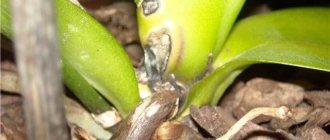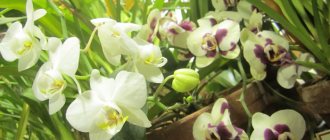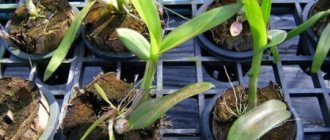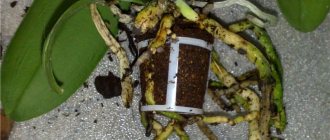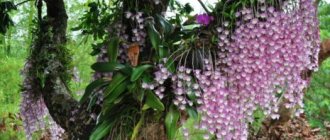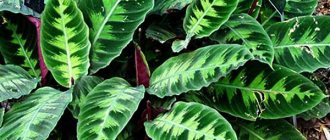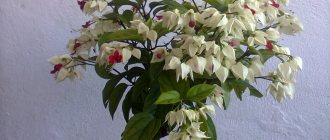You may have already come across the name of orchids as “mini-orchids”. Perhaps you have seen what they look like.
But everyone understands the definition of mini orchids differently. Which orchids are mini and which are not?
In many genera, small groups of orchids can be distinguished, differing in their smaller size compared to the main part of the genus.
There are simply low-growing compact specimens with flowers of different sizes, there are miniature ones, there are also real dwarfs with tiny flowers and leaves up to 2-3 cm.
Breeders are trying to breed as many compact hybrids with large flowers as possible.
And there is also a group in which the leaves are quite large, like those of large orchids (sometimes even larger), and the flowers are small and there are many of them.
This particular group is called mini orchids. And the word mini in this case refers specifically to the flowers, and not to the size of the indoor plant itself. Many of them have flower stalks that branch and form many small, lovely flowers.
But most flower growers by the word mini still mean miniature plants whose size does not exceed 20 cm. This group also includes some low-growing (up to 30 cm) hybrids of standard orchids.
Thus, there are about 700 species in the world. So we'll talk about them.
Mini-orchids of the genus Amesiella and Ancistrochilus
Amesiella Garay – Amesiella
The genus is named after the American botanist Ox Ames, who described many tropical orchids from Southeast Asia and tropical America. There are 3 miniature epiphytic species in the genus.
Amesiella philippinensis (Ames) Garay
Homeland - Philippine Islands. It grows as an epiphyte in tropical rain forests at altitudes up to 800 m above sea level. m. Monopodial epiphyte or lithophyte with a short shoot and rather large (5 cm in diameter) snow-white flowers, the most expressive part of which are long (3.5 cm) spurs filled with nectar. The lip has a yellow spot in the center. Branches usually appear in winter on fleshy, drooping flower stalks. Flowering continues until the first spring months.
Such a mini-orchid at home requires a moderately warm growing temperature (day - 18-30 ° C, night 13-26 ° C), strong diffused light (autumn-winter supplementary lighting is required) and average air humidity (50-70% ). In winter, watering is slightly reduced.
Block culture is preferred, but can also be kept in small pots with good drainage, breathable substrate, and with regular spraying.
Ancistrochilus Rolfe – Ancistrochidus
The name of the genus Ancistrochilus comes from two Greek words for “fishhook” and “lip” and reflects the structural features of the anterior blade of the lip with a thin, curved tip. The genus includes two species of small epiphytic orchids from the tropical rainforests of Africa (from Guinea to the Central African Republic, Equatorial Guinea, Congo, Uganda and Tanzania). They grow as epiphytes or butt epiphytes in lowland and montane tropical rainforests, as well as on coasts.
Ancistrochilus rothschildianus O'Brien
A sympodially growing epiphyte from tropical rain forests of Africa (from Guinea to Tanzania). Pseudobulbs are flattened, 2-3-leafed. The inflorescences are lateral, 6-8 cm long, the flowers are quite large compared to the shoots, 7 cm in diameter, bright crimson, fragrant.
Look at the photo - this mini-orchid has a purple three-lobed lip that is strongly bent back:
The flowers have a not very pleasant smell with a metallic tint. One of the few brightly colored compact African orchids. Blooms in summer, autumn and early winter. The plant is a moderately warm plant with a cool, dry winter, during which not only its leaves, but also its roots die.
At this time, the plants need to stop watering and need additional lighting (optimal illumination 10,000-20,000 lux). For abundant flowering, it requires clear differences in day and night temperatures. The relative air humidity should remain high at all times. Block culture is preferred.
Transplanting a dwarf flower
The need to replant a mini-orchid arises in the first days after purchasing the plant, especially if it was kept in moss. If the grower is inactive, the plant quickly dies, having survived the store flowering. It can be revived only with proper care. The most effective option would be to transplant a mini orchid after purchase into soil consisting of fractions of tree bark.
When starting to replant, it is important to decide on the type of new soil, as well as choose a suitable pot. The best soil would be a fine fraction, no more than 1 cm. It will provide them with lightness and the necessary breathability. A pot for mini orchids should be 1.5-2 times larger than the previous one. Varieties of mini orchids do not like to germinate in crowded spaces and will quickly die if the required container dimensions are not met. It is also important to pay attention to the following features:
- If you need to replant a houseplant growing in moss, this should be done during the growing season of the plant (in spring). That is, in order to plant a flower on new soil, you will need to wait until the leaves and peduncle form.
- Mini orchid varieties tend to have thin, brittle roots that are easily damaged during transplantation. Therefore, you will have to lower the pot into water so that the soil is saturated with water and separates itself from the root system of the plant.
- An alternative soil for planting is the specialized clay-wood substrate Seramis. In terms of its qualities, it is not inferior to wood material, and thanks to the addition of nitrogen, phosphorus and potassium, it acts as a biostimulator for Orchids.
The planted flower should not fall out of the container (when climbing onto the peduncle). It is located on the western side of the home. South windows will not work.
Transplanting a plant into a closed system
Most often, a mini orchid is grown in a specialized pot.
It is a container that does not have drainage holes. This can be ordinary plastic or clay pots for mini orchids, as well as other plastic and glass containers.
Planting mini orchids in a closed system will work provided the soil is properly selected. It is more advisable to use damaged flowers whose roots need saving. The soil must be specialized clay. It is useful to mix it with tree bark and moss or place them in layers.
Flowers of mini-orchids of the genus Ascocentrum
Ascocentrum Schltr - Ascocentrum.
A small genus of monopodially growing epiphytic or lithophytic orchids, numbering only 4-5 species. The name of the genus is made up of two Greek words - "askos" - bag and "kentron" - spur and describes the most remarkable feature of the flower - a short spur at the base of the lip.
Medium-sized orchids with short, hard, leathery leaves and thick aerial roots. The inflorescence (an erect or slightly curved multi-flowered dense raceme) bears several dozen wide-open, medium-sized flowers with a small spur.
The sepals and petals are similar, the three-lobed lip is motionlessly connected by its base and lateral lobes to the base of the column, and there is a callus-like outgrowth inside the lip.
Plants need warm or moderately warm growing conditions, strong diffused light, and high relative humidity (70-80%). During the winter holidays, the temperature may drop slightly, but not below 15 °C. During active growth, regular, abundant moisture is required, but during the dormant period, watering should be limited to avoid rotting of the base of the shoot.
Can be kept in pots, hanging baskets, or in potted blocks. During active growth, it requires abundant watering, strong diffused illumination (20,000-35,000 lux) and intensive fertilizing with complete mineral or organic fertilizers.
Ascocentrum ampullaceum - Vein-like Ascocentrum.
Homeland - tropical regions of the Himalayas, Burma and Thailand. Epiphyte, rises to low altitudes up to 300-900 m above sea level. Monopodially growing epiphytic orchid with fleshy, dense leaves 14 cm long, densely covered with purple dots. The roots are thick.
The inflorescences are dense, multi-flowered, short (up to 8 cm long), bearing many compactly arranged, pink-purple flowers with a diameter of 1.8-2.5 cm, sparkling in the sun. The petals and sepals of the flowers of this mini-orchid are almost the same shape, 0. 9 cm. The lip is small, brighter colored, 0.6-0.7 cm long. The spur is short, 0.7 cm long.
The column is short, round in cross-section. Blooms in February-July.
Ascocentrum miniatum - Rust-red Ascocentrum.
The species is quite widespread in South and Southeast Asia, from the Indian Himalayas to Indochina and the Indonesian Islands. Monopodially growing epiphyte, grows on the trunks of large trees. A small orchid with a relatively short, erect, strong stem, sometimes branching closer to the base.
The leaves are green, fleshy, grooved, toothed at the end, 5-28 cm long. The inflorescences of this dwarf orchid are formed in the axils of the lower leaves, they reach 24 cm in length and develop many small orange-red or yellow-orange flowers with a diameter of 1.0- 1.8 cm.
Petals and sepals are similar, elliptic-obovate, obtuse. The lip is small, pointed at the end, 0.4 cm long. The spur is straight, cylindrical, 0.7-0.9 cm long.
The flowering time of this species in nature is spring - early summer. In cultivated conditions, flowering plants can be found almost all year round, but the peak of flowering occurs in April, May and June.
Features of care
In order for a mini orchid to fully develop, bloom and look healthy, it must be properly cared for.
Watering
Most miniature orchids are grown on what is called a “cushion” of moss. It, unlike bark substrate, dries much faster. In addition, moss has the ability to absorb large amounts of water; the usual method of immersion or spilling when using it will lead to waterlogging. That is why watering mini orchids is best done by daily spraying.
If necessary, spraying can be supplemented with watering with a small amount of water. On average, only 1–2 tablespoons will be enough per plant. The water used for irrigation and spraying should be soft and slightly warm.
Fertilizer application
Due to the nature of watering, fertilizing mini orchids is carried out somewhat differently. If when growing standard plants the rule is to fertilize with every second watering, then when growing dwarf species with daily spraying instead of watering, it does not apply.
The most convenient way to fertilize a mini orchid flower is by using foliar fertilizers. To do this, use a special fertilizer for orchids, which is diluted in full accordance with the attached instructions. Spraying is carried out during the period of intensive growth from March to September with an interval of 2 weeks. You cannot fertilize during dormancy.
Transfer
Transplantation of mini phalaenopsis should be carried out no more than once a year. It is best to plan it for spring. At this time, the viability of plants increases greatly and they easily tolerate various damage to roots and leaves.
To transplant a mini orchid you must proceed as follows:
- Carefully remove the plant from the pot and immerse it in a container of warm water.
- Free the roots from old moss or bark.
- If necessary, trim off any dead or rotted areas of roots.
- Sprinkle areas of damage and cuts with cinnamon powder or charcoal.
- Distribute the roots evenly in the new pot, and fill the resulting voids with moss or a special substrate.
Attention! The new pot should be slightly larger than the previous one. A large amount of undeveloped root substrate can lead to rot and the spread of fungal diseases.
Dwarf orchids of the genus Bulbophyllum
Bulbophyllum Thou. - Bulbophyllum.
The generic name is composed of two Latin words - “bi” - two and “frenum” - bridle and reflects the structural feature of the stamens - 4 authentic ones are located separately on two stalks.
The genus consists of 26 epiphytic or lithophytic species from South America. Small to medium-sized orchids with tetrahedral olive-green single-leaved pseudobulbs and few-flowered short inflorescences.
Bifrenaria atropurpurea - Bifrenaria dark purple.
As you can see in the photo, this mini-orchid would be very appropriately called “black orchid”:
This striking plant with dark flowers is found on tree trunks only in the lowland forests of Brazil. A small sympodially growing orchid with tetrahedral cross-section, unifoliate pseudobulbs 6 cm long. As they age, the pseudobulbs become very wrinkled. The inflorescences appear at the base of the pseudobulbs from rather densely packed brown scales and bear 3-5 dark-colored flowers.
Fully opened flowers reach 4 cm in diameter, their petals and sepals are purple-brown, slightly lighter in the middle part. The lateral sepals are fused at their bases under the lip and spread horizontally.
The petals are smaller and directed forward. The lip is round, concave, bright pink and white, slightly wavy at the end. The column is short, wine-red, the anther calyx is white. The flowers of this species have a very pleasant aroma. Blooms in March-June.
When cared for at home, these dwarf orchids require a moderately warm growing regime with a winter night temperature of 14-18 ° C, high air humidity (70-80%) and strong diffused light. This species grows well on western windows, where it suffers less from direct sunlight.
Bulbophyllum - Bulbophyllum.
A large genus of more than 1,800 epiphytic, lithophytic or rarely terrestrial species, widely distributed in tropical and subtropical regions of Africa, Asia, Australia, New Guinea and the islands of the Indian and Pacific Oceans. Perennial symnodially growing rhizomatous herbaceous plants (often with thickened pseudobulbs).
Leaves from 1 to several. Inflorescences are single- to multi-flowered, racemose or umbellate. Flowers are of different sizes (from 0.5 mm to 50 cm), of various colors, sometimes with numerous projections not only on the lip, but also on the tepals of the outer perianth circle; the lip of the flowers is often movably articulated with the stalk of the column and in the middle part is curved back.
The wide range of the genus suggests that among the bulbophyllums there are both heat-loving and cold-loving species. All of the species listed below are well suited for indoor greenhouses; they require a moderately warm growing regime, moderate diffused light and constantly high air humidity.
Bulbophyllum disciflorum Rolfe
In culture, the species is also known as Trias disciflora (Rolfe) Rolfe. A small epiphytic orchid native to Thailand, Laos and Vietnam (up to 1500 m above sea level). The pseudobulbs are ovoid and very small (about 1.5 cm), collected in close clones, unifoliate.
The leaves are bright green, with pointed tips, fleshy, up to 6 cm long. Short inflorescences develop at the base of the pseudobulbs and bear a single greenish flower, 2.5 cm in diameter, which is densely dotted with red-purple dots on the inside. The lip has an even brighter purple color.
Flowering occurs in February-March.
Requires a moderately warm growing regime, moderate diffused light with mandatory shading from direct sunlight and high air humidity (80-85%).
Bulbophyllum frostii Summer. — Bulbophyllum frosta.
Homeland - evergreen low-mountain forests of Malaysia, Thailand and Vietnam (1450 m above sea level). Epiphyte or lithophyte of medium size. Long rhizomatous shoots with flattened single-leaved pseudobulbs.
The leaves are fleshy, oval, bluish-green. Inflorescences are few-flowered, short, umbrella-shaped, with well-defined bracts. The flowers are olive green, with dense dark purple spots and numerous warts. The lip is purple, bent backward, with a longitudinal central groove.
Blooms from December to April. Prefers block cultivation.
Bulbophyllum lobbii Lindl. — Bulbophyllum Lobba.
Homeland - low-mountain forests of Southeast Asia and Indochina (1300-1800 m above sea level). Long rhizomatous shoots with single-leaved ovoid pseudobulbs and petiolate leathery leaves. Inflorescences are single-flowered, erect.
The flowers are about 7.5 cm in diameter, light yellow with purple-brown stripes on the petals and spots on the sepals. The narrow, heart-shaped, pointed lip is movably articulated, and at the point of articulation there is a bright yellow convex callus.
Blooms from May to July.
Can grow well both in pots and on blocks, requires a moderately warm growing regime, and needs moderate light.
Bulbophyllum nipondhii Seidenf. — Bulbophyllum Nipponda.
Homeland - mid-mountain forests of Thailand, Vietnam and southern China (up to 1500 m above sea level). Epiphyte of small or medium size. Long rhizomatous shoots with single-leaved ovoid pseudobulbs and petiolate leathery leaves. Inflorescences are few-flowered, umbrella-shaped.
The flowers are 2 cm long, bright crimson, with purple veins on the sepals, which are connected along their entire length by their upper edges.
Usually blooms in April and May.
General description of plants
Mini orchids, which are often called dwarf or miniature, belong to the group of decorative flowering herbaceous plants. In their natural environment, these pretty flowers grow among rocks and in the expanses of the wooded part of the equator.
Not every gardener manages to find mini-orchids in our flower shops; more often they are brought to order. However, as we know, demand creates supply. As a result of the growing popularity of miniature herbaceous plants of the Orchid family, sellers of flower shops and gardening stores began to expand their assortment.
What is the reason for such a high interest of flower growers in these herbaceous crops, you ask? The main advantages of mini-orchids are long-lasting flowering, an abundance of color palettes and, of course, compactness. The height of an adult flower during the flowering period ranges from 15 to 30 cm. There are also more miniature specimens, the height of which does not exceed 10 cm.
Miniature cattleya and cochleanthes orchids
More recently, these cattleyas were part of the genus Sophronitis Lindl. They are common in the montane forests of Brazil, and require a cooler growing regime than most members of the Cattleya genus.
Cattleya cernua (Lindl.) Van den Berg - Cattleya oblique.
In culture, the species is also known as Sophronitis setia (Lindl.) Lindl. An epiphyte or lithophyte of small size from the low-mountain rain forests of Brazil (1000-1500 m above sea level). Psedobulbs are oval or cylindrical, unifoliate. Inflorescences are apical, 4-10-flowered.
The flowers are 2.2-2.7 cm in diameter, cinnabar-red, the lip at the base is orange-yellow with purple spots. Blooms in autumn or winter.
Requires moderate or cold growing conditions, strong indirect light and high air humidity (>80%). Daily temperature fluctuations should be 7-9 °C.
Prefers block cultivation.
Cattleya coccinea Lindl. — Cattleya scarlet.
In culture, the species is also known as Sophronitis alai (Sophrontis coccinea (Lindl.) Rchb.f.) An aegsphytic or lithophytic plant from Brazil, grows in lowland or low-mountain rain forests (650-1670 m above sea level) on moss-covered trees or on mossy stones. Pseudobulbs are fusiform, unifoliate, only 2-5 cm long.
Inflorescences are apical, 1-2-flowered. The flowers are 3 cm in diameter, scarlet, the base of the lip is orange-yellow with scarlet longitudinal stripes.
Mass flowering occurs in January, February, March and April.
Cochleanthes Raf. - Cochleanthes.
The genus consists of 40 species from the humid cloud forests of South America.
Sympodially growing epiphytes of medium size with small thickened pseudobulbs, two apical leaves and fan-shaped pointed green vaginal leaves on the rhizomes. Inflorescences are lateral, single-flowered.
Requires a cold growing temperature (summer - 27 ° C, winter - 8 ° C), strong diffused light and high air humidity (80%).
Cochleanthes flabelliformis
A small, delicate orchid from the shady, moist mountain forests of Venezuela, Colombia, Honduras, Nicaragua, Brazil and the islands. Jamaica (250-1200 m above sea level). Pseudobulbs are not pronounced; the leaves on each shoot form a kind of fan.
Inflorescences are 10 cm long, lateral, erect, single-flowered. The flowers are fragrant, 7.5 cm in diameter, white with a wide striped purple-violet lip. Blooms in March-June.
Plant of warm or moderate growing conditions. Grows well in conditions of constantly high air humidity, diffused light and with mandatory shading from direct sunlight.
Conditions of detention
Mini orchids are no less demanding of favorable conditions than other species of the orchid family:
- soil for the plant can be purchased at any specialized store, or you can easily make it yourself. The homemade substrate recipe consists of small pieces of bark, which must be thoroughly washed and left in water for several days before planting. When indoor humidity is low, flower growers recommend adding dry moss to the substrate, which perfectly absorbs excess moisture;
- As for temperature , delicate mini orchids prefer 20-24 degrees. Low temperatures can cause flowers to fall off. Miniature plants are very afraid of wind and drafts, so you should be careful about the temperature regime and remove flowers from the windowsill when frost sets in;
- the humidity quite high; an adult plant grows and develops well at a humidity of 50-70%, while a young plant needs moisture even more;
- The mini orchid does not accept excess light ; bright sunlight can cause burns to the leaves. An average level of lighting is preferable; it is best to place the flower in a place that is not the brightest.
Mini orchids epidendrum and helcia
Epidendrum peperomia - Epidendrum pereromia.
Grows in pine forests and oak forests of Colombia and Venezuela (600-2700 m above sea level).
A miniature epiphyte with thin branching, laterally compressed shoots forming thick cushions, double-rowed leaves ciliated at the edges and greenish-purple flowers with a glossy brown-purple obovate lip. The flowers are 2.5 cm in diameter, fragrant, waxy.
Blooms from February to May.
Requires moderate growing temperatures, strong lighting and constantly high air humidity (70-85%). Prefers block cultivation.
Epidendrum schlechterianum Ames - Schlechter's Epidendrum.
An extremely widespread small orchid, it is found along the Pacific coast of Mexico to Brazil and Peru, as well as on the islands of Trinidad and Jamaica. It grows as an epiphyte and lithophyte in a wide range of habitats from tropical rain forests to dry highlands, rising into the mountains to heights of up to 1100 m above sea level. m.
This species is located on a vertical substrate “upside down”; its not very long (10-15 cm) branching thin shoots from top to base are covered with fleshy succulent leaves 1-3 cm long, 0.3-0.4 cm wide.
The leaves have a purple midrib, a pointed bilobed tip and a keel on the outside. In spring, near the top of the shoots, from 1 to 3 flowers appear on short peduncles, so unusual that they are difficult to immediately notice among the leaves.
Most of all, the flowers resemble strange greenish-purple insects. The flowers, like the shoots, seem to be spread out on the substrate, they reach 2.5 cm in length and can be colored yellowish-green, greenish-bronze, reddish-green, purple or pink.
The flower segments are translucent and pointed. The wide lip is connected to the column up to half its length. Blooms in spring and summer.
Requires moderate growing temperatures, strong lighting and constantly high air humidity (70-85%). Prefers block cultivation.
Helcia Lindl. – helcia
A small genus of sympodially growing epiphytic orchids from tropical areas of America, including only 4 species. It is characterized by single-leaved, thickened pseudobulbs, drooping inflorescences with single flowers with a three-lobed lip.
Helcia sanguinolenta Lindl. — Helcia blood-spotted.
The homeland of this epiphytic orchid is Ecuador and Colombia (600-3000 m above sea level). Pseudobulbs 8 cm long, unifoliate. The leaves are up to 20 cm long, strongly tapering towards the base. The inflorescence appears at the base of the pseudobulb and develops a single flower with olive green petals and sepals covered with chestnut brown spots and a white lip streaked with carmine red veins.
The lip is long, bifurcated at the end, where its lobes diverge slightly to the sides, with jagged and curled edges, with two erect yellow shell-like appendages at the base near the column, between which there are two outgrowths.
The callus of the lip is yellow, and its anterior lobe is white, with red-purple spots and stripes that do not reach the tip of the lip.
It can bloom in May or late autumn and winter - from October to February. Requires a moderate growing regime (temperature in summer 18-26 °C, winter - 12-20 °C), moderate illumination (10,000 - 20,000 lux) and high relative humidity throughout the year.
Reanimation
Reanimation of an orchid is possible in two ways: outdoors and in a greenhouse . The choice of method depends on how damaged the roots are. If all the roots have rotted, then it is preferable to use the greenhouse method. In the event that there are intact roots left, it is better to choose the first option. The process can take one month or one year, it all depends on the scale of the problem.
In order to prevent such consequences, the causes should be eliminated at the moment they appear:
- If there is excess water or light, the plant may experience yellowness on the leaves.
- Too high temperatures and low humidity can cause flowers to drop early.
- Leaf rotting is a sign of improper care.
- When roots lack moisture, they shrink and darken.
Types of dwarf orchids of the genera Isabelia and Lelia
Isabelia Barb.Rodr. - Isabelia.
A small genus from Brazil, Paraguay and Argentina, including 3 species. These are miniature sympodially growing epiphytes or lithophytes with oval 1-2-leaf pseudobulbs, thin branching rhizomes and few-flowered apical 1-4-flowered inflorescences.
Isabella violacea - Purple Isabelia.
Also known as violet sophronitella (Sophronitella violacea (Lindl.) Schltr.). Endemic to Brazil, it grows as an epiphyte or lithophyte in moist montane forests at moderate altitudes. Pseudobulbs are ovoid, 2-3 cm long, 1-2-leafed.
The leaves are linear, v-shaped when cut. Inflorescences are apical, 5 cm long, shorter than the leaves, 1-4-flowered. The flowers are 2.5 cm in diameter, lavender-pink, evenly colored, wide open, with pointed petals and sepals. Blooms in late autumn and winter.
When cared for at home, this dwarf orchid needs a moderate growing temperature, bright diffused light (10,000-15,000 lux) and moderate air humidity (50-70%). It does not have a clearly defined dormant period, so it needs regular watering throughout the year. Prefers block cultivation or growing in small clay pots with a light, well-drained substrate.
Laelia Lindl. - Lelia.
The once fairly large Rodlelia has now been reduced to 25 species, transferring a significant portion to the genus Cattleya. The homeland of lilies is the tropics of Central and South America. These are sympodially growing epiphytic, lithophytic or terrestrial orchids with thickened 1- or multi-metameric pseudobulbs, 1-3 fleshy apical leaves and erect few- or multi-flowered inflorescences. The flowers are large or small, often brightly colored.
Laelia speciosa - Beautiful Laelia.
A miniature epiphytic orchid native to the mountainous regions of Mexico (1400-2500 m above sea level). Pseudobulbs up to 6 cm long, oval, 1-2-leafed. The inflorescence is apical, 1-2-flowered. The flowers are 12-18 cm in diameter, lilac-pink.
Look at the photo - this dwarf orchid has a lip that is wavy along the edge, with a longitudinal stripe, pale yellow inside the throat of the lip, white with purple spots in the middle and with a wide pink-purple edge:
Typically blooms from March to August, with peak flowering in March and June. Sometimes autumn flowering is observed (October).
Requires cold or moderately warm conditions (with a winter night temperature of 12-16 ° C), moderate diffuse illumination and high relative humidity (80%).
Flowering stimulates a winter dormant period, during which the temperature is lowered to 10-12 ° C and watering is reduced as much as possible. Well suited for cultivation on a block with completely exposed roots.
Planting and transplanting
The process of replanting orchids can be divided into several stages:
- Choosing the right soil for the plant. Preference should be given to the soil substrate, which consists of large particles of moss and bark, which have a beneficial effect on the growth of mini orchids, rather than ordinary soil;
- Choosing a container for planting and replanting a plant. For replanting, you should choose a container that is larger in size than the one in which the flower is currently growing. The roots should have plenty of room to grow and develop. But overdoing it is also dangerous; the size of the container should correspond to the size of the flower; you should not take the container “for growth”;
- Experts strongly recommend refraining from watering plants for the next 10 days after transplantation.
Step-by-step photo of orchid transplantation.
Experienced gardeners recommend replanting a healthy plant only if the flower pot has become small, or after 2-3 years, when the bark begins to decompose, the roots receive insufficient oxygen, which leads to the death of the mini orchid.
With continuous flowering, replanting an orchid should be treated with special care; the main task is not to damage the roots of the plant.
Miniature orchids of the genera Promenea and Psychopsiella
Promenaea Lindl. - Promenea.
A genus of epiphytic or lithophytic orchids from Brazil, including 19 species. Representatives of the genus live in humid low-mountain tropical forests, growing on rocky slopes and butt parts of trees. All promeneas are small sympodially growing orchids with convex pseudobulbs hidden in the bases of leaf sheaths and with single flowers up to 5 cm in diameter.
The best known in culture are the golden-yellow promenea (P. xanthina (Lindl.) Lindl.) and the stapelioides promenea (P. stapelioides (Link & Otto) Lindl.). All species of the genus require moderately warm keeping (winter night temperature 14-16 °C), moderate diffuse illumination and high relative air humidity (80%).
Preferably kept in small mesh pots or baskets.
Psychopsiella limminghei - Limming's Psychopsiella.
The only species of this monotypic genus lives in the tropical rainforests of Brazil and Venezuela. A miniature epiphytic orchid with small flattened pseudobulbs up to 2 cm long and rather large flowers compared to the plant itself (3-4 cm in diameter).
Petals and sepals, blunt at the ends, are brownish-orange or red, with light spots. The dorsal sepal is concave. The petals are reddish-brown with a yellow border around the edges. The lateral lobes of the bright yellow lip are also covered with numerous bright reddish-brown stripes and spots; they are narrow at the base and widen into vertical ears.
The anterior lobe of the lip has a narrow isthmus and can be directed upward or slightly curved. The column has comb-like wings. Maximum flowering occurs in the summer months - from May to September, but individual flowering plants can be found in late autumn and early spring.
Requires moderate warmth or moderate growing conditions, diffused illumination (18,000-25,000 lux) and high air humidity (75-80%). It does not tolerate stagnant water near the roots, so in winter watering is slightly reduced. Prefers block culture and regular spraying.
Differences between Phalaenopsis micro orchids and standard ones
In fact, the differences are insignificant. The structure of the flower is similar. The only difference is this:
- the height of an adult plant is about 20 cm;
- leaves are sinewy and dense, green in color;
- leaf length - up to 35 cm;
- buds are about 3 cm in diameter, there are up to 15 flowers on one peduncle;
- the root system is well developed.
Reference. Most Phalaenopsis grows from the ground. However, there are also varieties with aerial roots. They cling to the stone and grow on it. These species obtain nutrients from the air. It is worth noting that these varieties are very difficult to care for.
Distinctive characteristics of the species
Phalaenopsis mini (Phalaenopsis) grows a maximum of 20 cm in both height and width. It consists of branched peduncles on a straight stem with a large number of flowers, each shaped like a butterfly.
But the number of leaves is small - about 4-5 pieces. But this is enough for the flowers to be fully saturated with moisture and nutrients. Mini-orchids come in a variety of colors: from white to deep purple.
The most common colors: soft pink, white with lilac splashes.
The root system of the plant is powerful, despite its miniature size. The processes are well developed, their surface is covered with multilayer tissue. In favorable conditions, flowering begins in the spring and lasts up to 6 months.
Possible problems and difficulties
For the most part, miniature varieties of orchids are easy to care for. Of course, like all plants, they can be subject to some diseases or be affected by pests. In such cases, it is necessary to take appropriate measures to combat these ailments.
The most effective means here will be treating flowers with special compounds and fertilizing with fertilizers.
Mini orchids are a wonderful home decoration. They can be used as interior decorative elements, and are also often presented as an original gift.
Diseases and pests
Under poor conditions and improper care, orchids become sick and are affected by pests. Most often, the plant juice is enjoyed:
- thrips,
- aphid,
- scale insect,
- mealybug,
- spider mite
If you find signs of pest damage to a flower, treat it with an insecticide (Inta-Vir, Aktara). You can also get rid of aphids by washing the leaves and stems of the plant with a soapy solution.
Among the diseases of phalaenopsis, root rot is the most common. The reason for this is systematic waterlogging of the substrate and poor drainage. In this case, it is necessary to transplant the flower into a new pot with a new substrate. Before planting, remove all rotten roots and treat them with a 0.2% Fundazol solution.
Step-by-step instruction
Caring for a dwarf orchid depends on whether you just brought it home or whether it has been decorating the windowsill for a long time.
After the store
After the mini-orchid is brought home, everything is done to ensure that it endures stress with the least possible losses. Special conditions are created for her so that she adapts to the new conditions of detention and does not harm other indoor plants growing in the house.
First of all, keep the plant in quarantine. Its duration is several weeks. The pot is placed away from others, trying to ensure that direct rays of the sun do not fall on it in this place. The best choice is a shaded place. During the quarantine period they do not feed him.
The gardener’s task is to ensure complete and unconditional peace. This does not mean that it should be left without attention and observation. Both the leaves and the rest of the flower are inspected for pests.
After 2 weeks, they gradually tame it to sunlight , placing it on a lighted windowsill for a couple of hours a day.
On a note. During the adaptation period, do not use anti-stress agents and do not treat the leaves with insect repellents. Lack of watering during this period is the best way to quickly ensure that the dwarf orchid adapts to new conditions.
Further care
As soon as the adaptation period comes to an end (after 2 weeks), the mini-orchid is cared for differently. The pot is placed on the windowsill, where indirect rays of the sun fall. Flasks with water are placed not far from it if the humidity level is significantly below normal.



